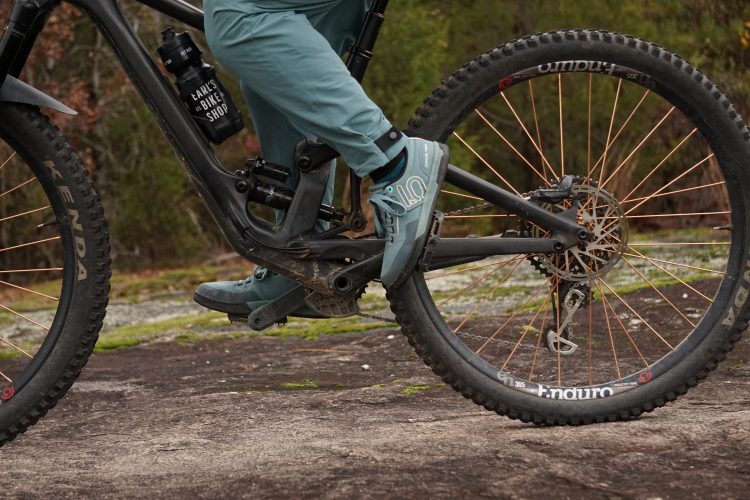
A few years back I was on a trip with, let us call him, Darren for this story. Darren works for one of the more prominent mountain bike companies and is a heck of a rider. We rode some proper Lost Sierra backcountry trail, and Darren was scorching through flat turns. It seemed almost like he was picking up speed through the turns rather than losing any. When we reached the bottom, I asked what magic powers he possessed to be able to corner like that.
Darren laughed and retold a similar story of following a coworker down a very similar set of trails. “I couldn’t understand how he put so much time into me in the corners,” Darren explained. “So I went home and looked up how to corner faster. Guess who wrote the article!!” We both laughed at the circumstances and pedaled off to the next trail.
Still, years later, I wonder what the science of hitting turns and maintaining speed and control is. With the boom of flow trail and arguably the overuse of berms, the art of flat turn seems lost in the weeds.
I reached out to mountain bike coach and freelance journalist Karen Brooks to walk me through the fundamentals of proper cornering skills. Karen possesses both of her Level 2 coaching certifications from PMIBA and BICP. She has been coaching and instructing riders from the beginner to expert levels for over eight years and has been riding mountain bikes for much longer.
Cornering is fundamental to riding bikes, a skill set that even the most experienced rider continues to work on improving. With all-new skills, riders should take their time, begin slow, and work on increasing their speed as they build confidence. When teaching new riders the basics of cornering, Brooks will often start students on the grass or pavement before taking it to the trail. Drilling proper body and bike position in a controlled environment allows riders to build a base of comfort before getting on singletrack. You can use cones, water bottles, or even trees in an open area to practice the fundamentals of cornering.
So now that you are comfortable on the bike let’s take it to the trail and walk through the steps to turning on a flat corner, i.e., one without a berm.
Karen points out that the turn starts way before the turn. Confusing? Perhaps a little, but what she is saying is true. When approaching a turn, proceed in a relaxed athletic position on the bike hovering above the saddle, knees bent, elbows bent at 90°, and body centered over the bike.
Karen points out a common mistake: “riders often situate themselves too far back on the bike,” compromising their control. A good point of reference is keeping your chin over the stem; this will allow your body to remain centered over the bike. Hinged at the waist with a flat spine and eyes focused on the apex of the turn will have you set up for success. Brooks will often drill home the cornering approach with clients using the phrase “Look, Low, and Lean.”

Next, check your speed. Proper speed is crucial to making it through the turn. Having your braking sorted out before committing to the turn is best. If you have waited until the turn has begun, it is too late, and you will be compromising your traction. While braking, you should spot the apex of the turn. The body follows the head, and Brooks points out that 80% of successful cornering begins with your line of sight. The phrase, “Look where you want to go, not where you don’t want to go,” is a good one to remember.
Now, it’s time to lean into the turn, tilting the bike to the inside while keeping your body weight centered over the cranks to counterbalance. Leaning the bike allows the outer knobs of your tires to dig on for traction. Your body should follow your eyes, pointing your pelvis, knees, and shoulders toward the apex and eventually the exit of the turn. Imagine that your eyes and pelvis are laser pointers directing the body through the turn. “You’re drawing a line with your eyes for your wheels to follow,” Brooks tells clients to reinforce the importance of looking through the turn.
Another tip is to put extra pressure on the outside foot. This helps the side knobs dig in even more. The pressure can be consistent if the corner is a smooth arc or can be a quick stomp for a more sudden change of direction. Pulling up on the outside of the handlebar at the same time keeps the bike leaning into the corner.
Remember that practice doesn’t always mean perfect, but incremental improvements; repetition is the best way to get better at any skill. Riders will often find that they are more comfortable cornering one direction over the other, so don’t neglect that weak side cornering, focus on the fundamentals, and have fun!

While you can corner on any bike, a few things that may make it easier is using a dropper post and tires with decent side knobs. A dropper post will allow the body more room for hovering over the bike and staying centered, giving the rider more control. An aggressive or semi-aggressive tread pattern will give tires a better grip on the ground, especially in corners. But, as Karen points out, “technique is everything.” All the fancy gear can not substitute for proper technique.
If you need a skills coach for an event or private lessons in the Pittsburgh area, you can reach Karen Brooks through The Wheel Mill.



















